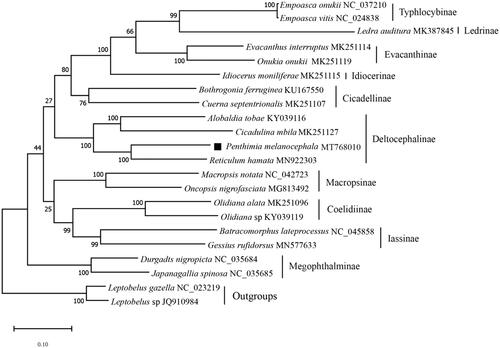Abstract
Penthimia is the largest genus in the tribe Penthimiini of the subfamily Deltocephalinae. To date, there are no available mitogenome sequences from Penthimia. In this study, we have sequenced and annotated the complete mitogenome of Penthimia melanocephala (Motschulsky 1863), the mitogenome is 15,308 bp in length, which including 13 protein-coding genes (PCGs), 2 ribosomal RNA genes (rRNAs), 22 transfer RNAs (tRNAs) and a long non-coding region (control Region), base composition of whole sequences are A (50.4%), C (15.3%), G (10.0%), and T (24.3%). All PCGs started with the typical ATN codon and stopped with the typical TAN codon except for COII and COIII stopped with single T. Within phylogenetic tree, Deltocephalinae members were clustered into a clade. The complete mitogenome of P. melanocephala can provide essential DNA molecular data for further evolutionary and phylogenetic analysis.
The genus of Penthimia was established by Germar in 1821, it is the largest genus in the tribe Penthimiini of the subfamily Deltocephalinae. To date, there are no available mitogenome sequences from Penthimia. Penthimia melanocephala was established by Motschulsky in 1863 and it was reviewed based on the examination of type specimens by Shobharani et al. (Citation2018). To better understand the diversity and phylogeny of Cicadellidae, the complete mitochondrial genome of P. melanocephala was first reported in this article.
Penthimia melanocephala from China was recorded and described by Li and Wang (Citation1991). Our samples were collected by sweep net from Mt. Huanglian, Yunnan Province of China (102°18′32″ E, 22°53′49″ N), in June 2019. The species identification was conducted by looking up the relevant literature (Shobharani et al. Citation2018). Male external genitalia and genome DNA are deposited in the Institute of Entomology, Guizhou University, Guizhou Province, China (GUGC-HCD-00114).
The complete mitogenome sequences of P.melanocephala were determined using next-generation sequencing method for the first time. All tRNA genes are identified by ARWEN version 1.2 software (Laslett and Canbäck Citation2008). The phylogenetic relationships of P. melanocephala were reconstructed by the maximum likelihood method with MEGA version 7 software, 1000 replicates of bootstrap were set. Each protein-coding gene (PCG) sequences were aligned using the MAFFT algorithm in TranslatorX and aligned sequences were eliminated using Gblocks 9.1b (Abascal et al. Citation2010).
The complete mitogenome of P. melanocephala is 15,038 bp in length (GenBank Accession Number: MT768010), which including 13 PCGs, 2 ribosomal RNA genes (rRNAs), 22 transfer RNA genes (tRNAs), and 1 major noncoding region referred to as the control region, base composition of whole sequences are A = 50.4%, C = 15.3%, G = 10.0%, T = 24.3%, the A + T content of the whole mitogenome was 74.7%, which is within the range reported from Hemipteran mitogenomes (68.86–86.33; Wang et al. Citation2015). Total length of 13 PCGs is 10,943 bp, encoding 3636 amino acids. As the longest gene, the ND5, which has containing 1680 bp, locates between trnF and trnH. Between COIII and ND3, there is the shortest gene which is trnG, the length of trnG is 60 bp. Furthermore, the position of the control region is between srRNA (12S) and trnI and the control region contained 1007 bp. The lrRNA (16S) located between trnL2 (CUN) and trnV contains 1180 bp, the srRNA (12S) containing 737 bp located between trnV and control region. All PCGs started with the typical ATN codon and stopped with the typical TAN codon except for COII and COIII stopped with single T.
Phylogenetic analysis using nucleotide sequences of 13 PCGs was conducted with 22 species of Membracoidea from 11 subfamilies. The available mitogenome sequences of 21 species downloaded from GenBank and two species of Membracidae as outgroups. Result clearly indicated that P. melanocephala and Reticuluma hamata were clustered into a clade and P. melanocephala belong to Penthimiini of Deltocephalinae (). Currently, only one study has been recorded for Penthimiini (Xu and Dai Citation2020), and this study provides molecular data for further phylogenetic and evolutionary analysis for Deltocephalinae.
Disclosure statement
No potential conflict of interest was reported by the author(s).
Data availability statement
The data that support the finding of this study are openly available in NCBI at (https://www.ncbi.nlm.nih.gov), reference number [MT768010].
Additional information
Funding
References
- Abascal F, Zardoya R, Telford MJ. 2010. TranslatorX: multiple alignment of nucleotide sequences guided by amino acid translations. Nucleic Acids Res. 38:W7–13.
- Laslett D, Canbäck B. 2008. ARWEN: a program to detect tRNA genes in metazoan mitochondrial nucleotide sequences. Bioinformatics. 24(2):172–175.
- Li ZZ, Wang LM. 1991. Agriculture and forestry insect fauna of Guizhou (Homoptera: Cicadellidae). Vol. 4. Guiyang, China: Guizhou Science and Technology Publishing House; p. 154–155.
- Shobharani M, Viraktamath CA, Webb MD. 2018. Review of the leafhopper genus Penthimia Germar (Hemiptera: Cicadellidae: Deltocephalinae) from the Indian subcontinent with description of seven new species. Zootaxa. 4369(1):1–45.
- Wang Y, Chen J, Jiang LY, Qiao GX. 2015. Hemipteran mitochondrial genomes: features, structures and implications for phylogeny. Int J Mol Sci. 16(6):12382–12404.
- Xu TL, Dai RH. 2020. Complete mitogenome of Reticuluma hamata (Hemiptera: Cicadellidae: Deltocephalinae) from China. Mitochondrial DNA Part B. 5(2):1437–1438.

